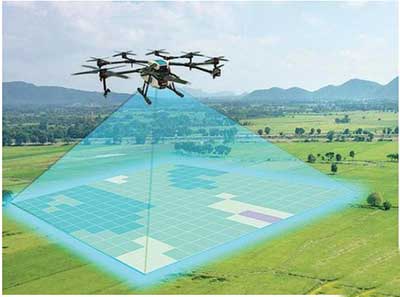Relevance: GS-3: Science and Technology-developments and their applications and effects in everyday life. Technology missions in Agriculture sector.
Key Phrases: Indian agritech, Robots, Big data, Farm mechanisation, PPPs, Market linkage, Farming as a service, E-Sahamathi, Quality management, Supply chain tech, Convergence of programmes, Agriculture startups, Machine learning.
Why in News?
What is Agritech?
- It primarily refers to an ecosystem of companies and startup
enterprises that are
- Capitalising on technological advancements to deliver products or services for increasing yield,
- Efficiency– both in terms of time and cost,
- Profitability for farmers across the agriculture value chain.
- This includes using technology to achieve faster planting, modified crops that grow well in different environments, and harvesting.
- It can also be the use of robots, big data, AI or any methods necessary in order to solve the challenges that the agricultural industry faces.
Do you know?
- India currently has over 1300 agriculture startups – which are actively employing Artificial Intelligence (AI), Machine Learning (ML), Internet of Things (IoT), etc. – to increase efficiency and productivity in the sector.
- Karnataka, Maharashtra and Delhi-NCR had the most number of Agritech startups in the country.
- The Indian Agritech market is expected to grow at a CAGR (revenue) of 32 percent from FY20 to FY25.
- It is estimated that $10bn will be invested in Indian Agritech startups over the next 10 years.
How Agritech helps the agriculture farmer?
The various segments within the agriculture sector where agritech can be helpful. Like
- Market linkage farm inputs:
- Digital marketplace and physical infrastructure to link farmers to inputs.
- Biotech:
- Research on plant and animal life sciences and genomics.
- Farming as a service:
- Farm equipment for rent on a pay-per-use basis.
- Precision agriculture and farm management:
- Use of geospatial or weather data, IoT, sensors, robotics etc. to improve productivity; farm management solutions for resource and field management, etc.
- Farm mechanisation and automation:
- Industrial automation using machinery, tools and robots in seeding, material handling, harvesting, etc.
- Scientific innovations and technology enablement have introduced new-age farming techniques and services for farmers, lenders, merchants, and corporate farm produce buyers, among other stakeholders.
- Farm infrastructure:
- Farming technologies, such as greenhouse systems, indoor-outdoor farming, drip irrigation, and environmental control, such as heating and ventilation, etc.
- Quality management and traceability:
- Post-harvest produce handling, quality check and analysis, produce monitoring, and traceability in storage and transportation.
- Supply chain tech and output market linkage:
- Digital platform and physical infrastructure to handle post-harvest supply chain and connect farm output with the customers.
- Financial services:
- Credit facilities for input procurement, equipment, etc. as well as insurance or reinsurance of crop.
- Advisory/ Content:
- Information platforms online platform for agronomic, pricing, market information.
CASE STUDY
- The e-Sahamathi initiative of Karnataka enables the sharing of agriculture and horticulture data from its database of more than 7 million farmers with start-ups/service providers and Telangana is working towards establishing agriculture data exchange ADEx. Access to digital financing and insurance services for hugely underserved smallholding and women farmers needs data from digitised land records, crop-cutting experiments, satellite images, fertiliser consumption and crop history.

How agritech is fuelling new-age jobs?
- Changed the perception:
- Agritech players have changed the perception of the agriculture sector, piquing the interest of employees, entrepreneurs, and investors alike.
- By creating a social cohesion of the three Es of Employment, Economic growth, and Empowerment in the hinterlands.
- Emerging opportunities
- It creates a surge in demand for talent that understands technology and uses resources to benefit those with a limited understanding of these new trends.
- It also offers an opportunity for those interested in developing cutting-edge innovations, including Artificial Intelligence (AI), Machine Learing (ML), analytics, cloud computing, cyber security, Internet of Things (IoT), and Blockchain, among others.
- Livelihood to rural population:
- Leading to direct livelihood opportunities in remote areas.
- Integrated agritech players offering tech-led warehouse services, digital lending services and marketplace platforms, the on-ground talent gains exposure to multiple domains for a fast-track career progression.
- New horizons for Millennials
- Multiple research reports indicate that Millennials aspire to work for a higher social cause and positively impact society.
- The agritech sector is in sync with such Millennial expectations.
- The transformations enabled by it fuel unprecedented socio-economic benefits for the rural heartland.
- Inclusive opportunities:
- Startups in agtech are facilitating role of women in agriculture, and transition this from labour to leadership.
- They are partnering the women to equip them technologically and financially, to drive a gender-diverse leadership agenda and accelerate a rise in income.
-
The World Economic Forum has launched the AI4AI (AI for Agriculture Innovation) initiative and Food Innovation Hubs in collaboration with the Ministry of Agriculture and multiple State governments with the intent of enabling and scaling PPPs for driving innovation across the agriculture ecosystem, establishing toolkits and frameworks through evidence based learning from pilots on ground.
Way forward:
- In recent days, startups have been facing business challenges and layoffs, often due to a cash burn financial model. Therefore, agritech must build a viable business model to build on sound economics.
- This ensures growth that is mindful, inclusive, and sustainable, thereby ensuring job security.
- The rising influence of technology in the agriculture ecosystem is opening up greener and newer pastures for the country’s youth. The onus is on the stakeholders, including academia, to adequately equip the young aspiring professionals for future opportunities and challenges alike.
Source: The Hindu BL
Mains Question:
Q. Agritech is stated to be a boon for Indian economy in general and agriculture sector in particular. Examine.







